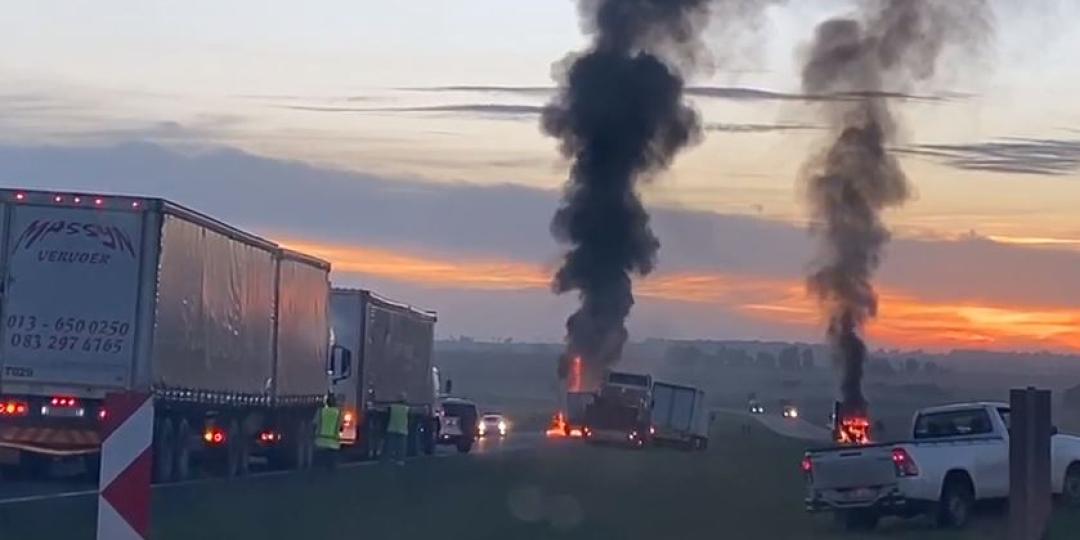Trucks were set ablaze on the N3 striking fear that another unrest could be on its way Photo Freight News
South Africa – The July riots in South Africa left an indelible mark on the nation, affecting the lives of its citizens in profound ways. On the eve of the two year anniversary, the burning of trucks in KwaZulu-Natal reignited those memories of the unrest for those who lived through those eight harrowing days.
Eight Days in July, co-authored by Qaanitar Hunter, Jeff Wicks, and journalist Kaveel Singh, shed light on the events that transpired during the unrest. The authors employed a three-pronged approach, combining on-the-ground reporting, insights from intelligence colleagues, and information from the security cluster, explained Singh.
Racial tensions and the threat of divisions
During the unrest, there were concerns that racial divisions could escalate, particularly between the Indian and African communities. The events in Phoenix and other communities highlighted the need to address the underlying issues of poverty and inequality, which contribute to the existing racial tensions. While progress has been made in fostering unity, there is still work to be done to alleviate racial tensions and bridge the divides that persist.
“It really could have spelled into heavy racial wars. Presently we still have a lot of racial tension between those various communities surrounding Phoenix. I think there is some sort of headway that we can look at and say we are making some progress in terms of unity. One of the testimonies that the provincial commissioner in KwaZulu-Natal gave during that period, General Nhlanhla Mkhwanazi. He said that a lot of the arrests that they made from the Indian community, in particular people, those tip-offs came from within the Indian community. So it was a clear show that there were a lot of people in Phoenix that weren’t happy with the sort of racial divide where people were getting stopped based on the colour of their skin.”
Rogue elements, such as drug dealers in Phoenix who went unchecked by authorities, played a significant role in fueling the unrest and exacerbating racial tensions, said Singh. He had got reports that some drug dealers were handing out illegal pistols to the young men who were their customers. These drug dealers took advantage of the chaos, further destabilising the affected areas.
The fear of another unrest and rogue elements
Singh explained that there is very much still a fear that another unrest could happen. When the trucks were being burnt on the N3 highway at Van Reenen’s Pass, his phone would not stop ringing. Police officers and security companies were eager to find out if he had any information on why trucks were being targeted and burnt.
“There were these rogue elements that were going around [during the July unrest] and we mentioned this in our book, that the modus operandi that we saw on the ground… were people who would go to certain key points, key roads with unmarked vehicles with tires loaded in the back of the vans. They would block these key roads and set it alight. They would go to these very large factories, very large businesses and they would break in… They really weaponized poverty. They weaponized poor people who really have almost nothing. They’ve been left with nothing from our government for so many years.”
These rogue elements played a massive role in the racial tensions, inciting violence and weaponizing poverty. The unrest came just after the Covid pandemic when people were desperate and many had lost their jobs which they took advantage of to their full benefit. The failure to address these underlying issues prior to the unrest highlights the urgent need for effective governance, crime intelligence, and security measures.
SMread: Dooiy App Provides Life-Changing DIY Solutions for South African Communities
The possibility of another unrest
Over the weekend, trucks were being set alight. By this Monday,16 trucks had been set alight in KwaZulu-Natal. There is a fear that another unrest could be brewing. The July unrest exposed vulnerabilities within South Africa’s security agencies. Vulnerabilities which still exist today. The inadequate training and preparedness of the South African Police Service (SAPS) and the South African National Defense Force (SANDF) were apparent. Communities were left to protect themselves, with many feeling abandoned and some not having the firepower to protect themselves. These shortcomings demonstrated the pressing need for improvements in security agencies and intelligence services to safeguard the nation effectively.
“The reason why we can comfortably say it’s possible that something like this could happen again is because the intelligent services and our police largely haven’t improved that much. We still find that, even during that time there were factional battles at play which is why our intelligence services were stunted.”
Warnings were given but the intelligence services’ failed to act upon these warnings and Singh fears the same could happen again. Documents were provided to indicate the July unrest could happen but they failed to act on the evidence provided..
As South Africa moves forward, it is essential to remain vigilant and proactive in preventing future unrest. The collective trauma and tension that still linger underscore the need for continuous efforts to build a more secure and united South Africa. The July unrest was a stark reminder of the challenges the nation faces.
Addressing the underlying issues of poverty, inequality, and corruption, while strengthening security agencies and fostering unity, will be crucial in preventing future crises. South Africa stands at a crossroads, and it is the collective responsibility of its citizens, leaders, and institutions to chart a path toward a more secure and prosperous future.
Kaveel Singh discussed with Julie Alli the possibility of another unrest as well as how citizens can ensure their safety and what the government needs to do. Listen to that discussion here:
